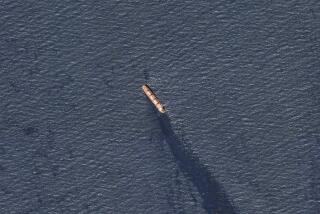Adventure in the Desert . . . From a Ship’s Deck : Cruise ship transits the Suez Canal, parting the sands en route to Red Sea from the Mediterranean.
- Share via
The sun was egg-yolk yellow that morning, spilling across the Sinai sands and onto the alabaster mosques of Port Said. Ferry boats, heavy with Egyptian commuters, cut in front of our cruise ship--the Seabourn Spirit--as we waited to transit that remarkable 19th-Century shortcut: the Suez Canal.
I stood on the bow, sipping coffee, savoring the balmy desert air, and listening to the clatter of voices from shore: the shouts of fishermen, of Middle East merchants, of a port city awakening after the cry of the muezzin.
Although I had never been through the Suez, I had developed a fuzzy image of a Panama Canal in the desert, another mechanical marvel with lots of gears and gates. But the 100-mile Suez, which opened in 1869, is an older and simpler waterway. There are no locks or giant cuts, since the Mediterranean and the Red Sea are virtually the same level.
Basically, the Suez is a slash in the sand, a slash sometimes less than 200 feet across that shortened the maritime distance from Northern Europe to India and the Far East by 4,000 miles.
The canal is one lane, and one way. Our southbound convoy had to wait a couple of hours for northbound traffic to clear. But no one whined. There was a giddy spirit of adventure on deck, and film went fast as passengers lined up for lifeboat drill photos with the desert as background.
From the start--in Israel--this had been a different sort of voyage, a repositioning trip in which the Spirit was moving from a season in the Mediterranean to cruise in the South China Sea. There would be calls along the way in ports that are rarely on travelers’ top 10 lists: Safaga, Egypt; Aden, Yemen; Male, Maldives. There would be 11 days at sea--five in one stretch.
Finally, when our captain got the word that the Suez was clear, the 3-year-old Seabourn Spirit led the bizarre parade, followed by a rusty freighter on the way to the Persian Gulf, a passenger ship from Cyprus and a battleship-gray container ship.
We glided through the canal for 15 hours, sometimes with nothing but rippled sand in either direction, sometimes broken by a distant row of telephone poles following narrow-gauge train tracks. Most often ships were the tallest objects in sight. A startling burst of green turned out to be Ismailia, an oasis of a town with century-old pine groves, eucalyptus and poplars.
The grandiose dream of the Suez by Frenchman Ferdinand de Lesseps--and the story of its 10-year excavation--are far more dramatic than the passage itself. Our hours were filled with lively lectures, sunbathing and, of course, dining. At nightfall we were still in the canal; the lights of a village flickered on the shore of a stretch called Great Bitter Lake. It could have been a mirror to the stars.
Before falling asleep, I decided that of all the intercom announcements that brightened our strange, foreign transit, my favorite was when the captain, a Norwegian named Daniel Danielsen, was attempting to interview the Egyptian port pilot from Port Said:
“I’m told you have many interesting industries here,” said Danielsen.
“Yes,” said the pilot.
“I’m told you have many, many fish farms here,” said Danielsen.
“Yes,” said the pilot.
“What kind of fish do you have in your farms?” asked Danielsen.
There was a long pause.
“Local fish,” said the pilot.
No wonder I love to travel.
More to Read
Sign up for The Wild
We’ll help you find the best places to hike, bike and run, as well as the perfect silent spots for meditation and yoga.
You may occasionally receive promotional content from the Los Angeles Times.






